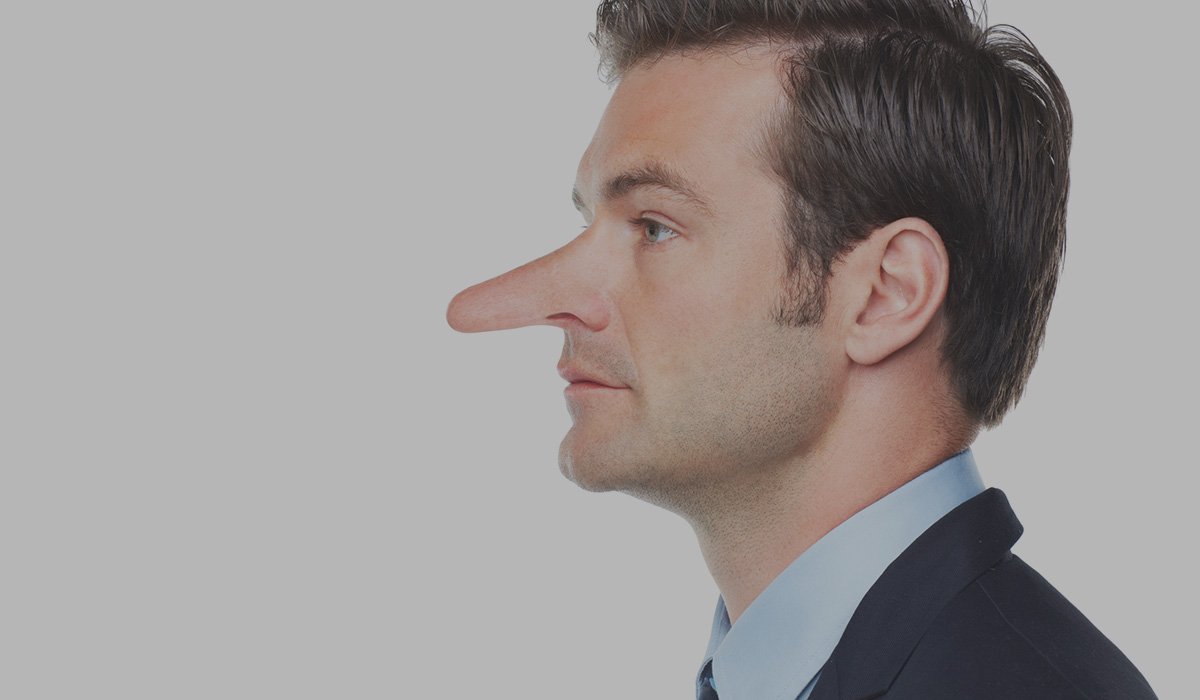Is Your Conversion Ratio Accurate or Just a Bold Faced Lie?
How many blog subscribers do you have? What kind of conversion ratios are you achieving? How much money did you make from that offer?
These are questions most of us might not want to answer publicly. They bring up the kinds of vulnerabilities or exposures we’d rather not have… much less admit to. As a result, we may be inclined to stretch the truth a little bit when asked about them.

View all of the posts in our Cognitive Biases in marketing series.
Consciously or subconsciously, we want others to come away with good impressions of us, so we tend to over emphasize the positive aspects of our efforts and take the focus away from shortcomings. This is true whether those drawbacks are real or perceived.
There is a scientific term for this phenomenon, of course: social desirability bias. As with all types of psychological tendencies, anyone can be affected. In fact, we can be tempted to inflate our own achievements even without being aware we are doing so.
Social desirability bias affects our thinking and attitudes on some topics more than others. The more something affects our sense of status or expertise, the more likely we are to offer exaggerations to ourselves and others.
For instance, the examples I gave at the opening of this article all point to external measurements that help us determine our place and value in the business world.
One reason why we avoid data we don’t like is that it almost always indicates a problem, and nobody likes problems. The irony is that solving problems is the fastest and most enduring way to learn and grow. If you can embrace the problems undesirable data causes as opportunities for creativity, you become a much better marketer.
Mark Traphagen
Senior Director of Brand Evangelism
Things like income, popularity, and public feedback all hit at emotional hot buttons. And so, when we are prodded to answer questions about them – or just to think about our own strengths and shortcomings in these areas – it’s difficult to get to the truth.
In fact, we may be tempted to put a finger on the scale by buying an “instant” social following, pumping up our reputation through falsified reviews, or exaggerating our own successes. We might do these things because we think others will be fooled, or simply because we want to feel better even though we know what we are seeing isn’t completely real.
As marketers, what we want to hear isn’t the same as what we need to know. In fact, the more sensitive something is, the higher the likelihood that the truth and the information presented are going to be far apart from one another.
How can we gather important information on marketing personas, analytics, and buying motivations when social desirability bias keeps people from answering questions honestly? Here are a few tips you can use to get to the information you need…
1. Consider Social Desirability Bias When Evaluating Surveys and Questionnaires
Any time you put a survey or questionnaire to the public, or even just a group of your customers, you have to know that some of the answers you receive are likely to be skewed.
That’s partly because people tend to respond when they have the most to brag about, or a certain point of view to advance. However, social desirability bias also plays a big role.
When looking to determine things like income, budgets, or career success, take anything you get directly from someone who’s completing a survey or questionnaire with a grain of salt.
It may not be that you are being willfully deceived, just that person is going to instinctively look on the bright side of their own condition. This is particularly true if they can be identified through their answers. Just take a look at any salary survey to see it in action.
One good way to reduce the effect of social desirability bias is by making all of your surveys and questionnaires completely anonymous. People will still be tempted to hide uncomfortable truths, but they are likely to be a little more forthcoming if they feel they can share without any repercussions.
2. Look For Social Desirability Bias in Your Own Behaviour
In many ways, the hardest part of dealing with any psychological phenomenon is understanding how it affects our own thoughts and behaviours. It’s easy for us to think that other people would exaggerate their looks, finances, and fitness, but surely we wouldn’t have any reason to do the same… right?
Studies show that we are all susceptible to these types of activities. As I’ve noted above, we don’t even always engage in them consciously. We think of our own charity work, for example, while forgetting about the drivers we cut off on the way to work. We see ourselves as being in the top few percentage points of success, even if statistics tell us otherwise.
One thing we always have to be doing as marketers is evaluating our own performance and seeing how we can improve. By being aware of social desirability bias, we can keep tabs on whether we are actually telling the truth to ourselves and the people we work with.
If not, then we can actually undermine our own effectiveness by withholding the information or insights that are needed to solve a problem.
3. Remember That Actions and Results Speak Louder Than Words or Thoughts
In the end, the best way to combat social desirability bias is simply to observe actions and results. After all, these will lead us to underlying patterns, situations, and motivations.
If customers tell us they are doing great, but only buy products or services that are on sale, then we might need to accept that they are more price conscious than we anticipated. That’s a simple example, but it points to the kinds of realizations you can get to when you understand buyers might not be telling the whole truth, all the time.
Luckily, in the digital age we don’t have to guess about what’s going on in someone’s mind as much as we used to. We can simply study website statistics, heat maps, and other modern tools to see what buyers react to.
Behavioural observation will always win out over surveys and questionnaires, especially as we deploy and refine our campaigns over time.
Social Desirability Bias is Real, But You Can Beat it
The desire to improve our standing, and to guard ourselves against being looked down upon, is an innate part of the human psychological condition. That’s why you can’t completely remove social desirability bias from your work, even in situations where people can offer anonymous feedback. The best you can do is know that it exists, recognize it in yourself, and evaluate your campaigns accordingly.
What you want to hear, or what others want to tell you, isn’t necessarily accurate. Keep that in mind and you can become both a smarter marketer and the kind of person who gets to the truth of any situation.
Learn how we apply behavioural insights into lead conversion optimization using HubSpot Software.
{{cta(‘d182cecd-8058-469a-bfe8-fdebc57bd81e’)}}
You need a business partner. Someone who will take the trouble to understand your business and then work like it is theirs, adding their in-depth skills and expertise to your company’s mix. Marketing, branding and the ‘simple’ ability to do business have changed.
David Amerland
7-time Best Selling Author on the topics of Online Marketing and the Semantic Web






![How to Create Your Buyer Persona [live webinar transcript]](https://kayakwebsites.com/wp-content/uploads/sites/107/2020/09/buyer-personas-iStock-1257975893-768x448.png)
